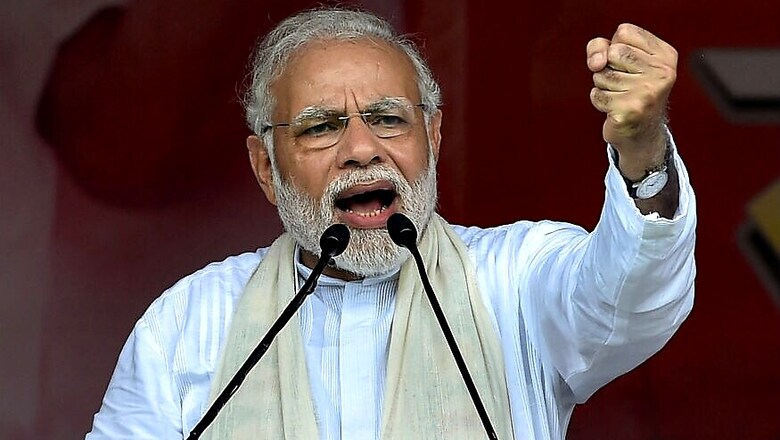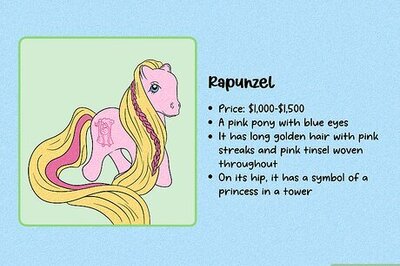
views
New Delhi: When the Narendra Modi-led National Democratic Alliance (NDA) government completed four years in office, the government threw up a startling figure. Schemes of the NDA government had directly benefited 22 crore citizens across India.
With less than a year to go before the 2019 Lok Sabha elections, the NDA has set its eyes on an ambitious target – one that won’t be without its fair share of challenges. According to sources, the Prime Minister’s plan is to directly communicate with each of the 22 crore beneficiaries that his government claims to have helped.
“The government’s schemes have benefited 22 crore people. The Prime Minister wants to send across a very clear message. These are the forgotten men and women of India. They always existed but they were ignored till his government decided to turn to them. He is currently trying to communicate with each and every one of them. They are the poorest of the poor and Modi wants to build a personal connection with all of them. At no point during this outreach will the PM ask for votes. Because if he has to appear as a father figure, he can’t ask for anything in return,” a source close to the PMO said.
Sources pointed out that with an outreach program of such a scale, there cannot be just one method of outreach. “Areas and demographics are mapped out and we try to ascertain the best way to reach a particular group of people. For example, beneficiaries of Ujjwala Yojana in Madhya Pradesh or Rajasthan may be big Facebook users, so we will use that platform. Beneficiaries of Ayushman Bharat in tribal areas like Bijapur or Bastar don’t have access to even internet, so a road show or a rally would be a better way to reach out,” another source said.
However, in this massive outreach program, the government has a secret weapon – the Narendra Modi smartphone app. Over the last month, Modi has held interactions via videoconferencing with beneficiaries of six government schemes and three specific special interest groups such as farmers, investors and even with the Saurashtra Patel Cultural Samaj. All these interactions have been streamed on the NaMo App.
Ad man Prahlad Kakkar said this showed innovation. “This style of direct outreach personalises the campaign. In addition to that, it’s irrefutable. Numbers can be disputed, but personal experiences of people whose lives have gotten better cannot be refuted. That person becomes part of the process. Don’t believe Modi if you don’t want, but believe the man on the ground who has actually benefited.”
Santosh Desai, marketing expert and MD & CEO of Future Brands, said, “The aim seems to be to set up a direct link of communication. It is so that the benefit doesn’t become something that comes from an abstract entity called the government. It is to directly attribute the work of the government to an individual, in this case the leader of the government.”
Kakkar added that including “interactions” in his communication strategy will help Modi avoid the charge that he avoids two-way communication. “Opposition says Modi is a dictator. But with a campaign like this, he is planning an inclusive image. He is including people in the decision making process. That paints the picture of a democrat, not a dictator.”
And certainly, the Modi that is seen during election rallies and large public meetings is a very different orator from the one seen in these interactions. In the interaction with Ujjawala Yojana beneficiaries, for instance, Modi appears more personable, more approachable. The high-octave, high-decibel oratory makes way for a more conversational tone.
In this particular interaction, he spoke about rumours that “rich people” used to spread when he was a young boy. “When I was young, rich people used to tell poorer folks not to have LPG cylinders in their homes since it could lead to fires or something in the house would get damaged. I used to call them out because they didn’t want the poor to have the same benefits as they had.” In every interaction, there is an attempt to create a “man of the people” image around him.
Through these 22 crore people, the government aims to create a “ripple effect”. “If the PM speaks to me, I will tell 15 other people. “I spoke to Modi, I have benefited”. This will create a ripple effect,” Kakkar said.
Such a campaign is not without its challenges. For starters, since its launch four years ago, the NaMo app has garnered over 5 million or 50 lakh downloads. This does not include data on the number of active users. While 5 million is not an insignificant number, it seems to be a drop in the bucket when stacked up against the scale of the outreach. Five million downloads is less than 0.4% of India’s population and around 2.2% of the total number of beneficiaries that the government claims. To have their communication strategy on platform which is available to only a small proportion of Indian voters may seem risky.
However, sources close to the PMO are confident that the NaMO app will pick up in the coming year. “The NaMo app is highly visible. It is advertised on Doordarshan, on all India radio and even the PM mentions it during his Man Ki Baat program. The number of downloads of NaMo app will grow exponentially before the Lok Sabha election,” said a source not willing to be identified.
In addition to the numbers, Desai cautioned the government to be careful about how these interactions are managed. “They need to make sure that the communication must be meaningful. If you reach out to someone and they don’t have a mechanism to respond, it takes away from the meaningfulness of an interaction. If it’s a one-way interaction, you stir up resentment. Because you create certain expectations. Presumably this is something that they’ve thought through, but this is still something that they must be careful of,” he said.
He added, “Whether or not it works is something that remains to be seen. It is certainly something that is innovative. Talking to people directly is a good idea but how much will it translate into actual, long term electoral success is something that we will discover. We still don’t know how many of the 22 crore people are literate or have access to the internet. But my overall take is that it can’t do any harm and if it works, it’ll be a first. So its worth a shot.”



















Comments
0 comment